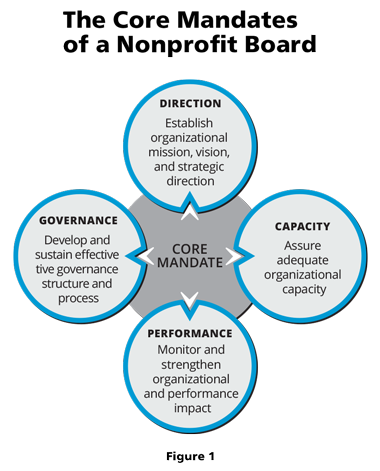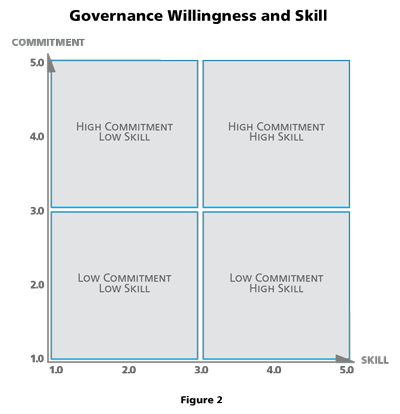How Effective is Your Nonprofit Board?
Good governance matters. Our research around the world demonstrates that the correlation between organizational impact and effective governance is both positive and significant.
This discovery introduces a very important question: how effective is your nonprofit board? Are you confident that you are making a significant contribution to the organization’s effectiveness? Is the board’s performance leaving anything on the table? To answer these questions, one must first ask, “As compared to what”? To what standard are we, as a board, to be measured?”

To achieve maximum mission impact, a nonprofit board must exercise 12 responsibilities with excellence. It is against these standards that the board measures its effectiveness. While the order of priority and wording of these responsibilities may vary between organizations, most agree that these descriptors accurate capture trustee obligations. We have taken these responsibilities and organized them under four overarching mandates (Figure1).
- Direction: Establish organizational mission, vision, and strategic direction
- Establish the mission, vision, and core values of the organization
- Approve the strategic and operating plans of the organization
- Capacity: Assure adequate organizational capacity
- Recruit and select the chief executive
- Evaluate the chief executive’s performance and provide needed support
- Ensure the organization has sufficient capacity and resources
- Performance: Monitor and strengthen organizational performance and impact
- Provide financial, organizational, and program oversight
- Establish accountability for ethical and legal conduct
- Monitor and strengthen the organization’s image and reputation
- Ensure the organization’s programs and services fall within the mission boundaries and are achieving the desired outcomes
- Governance: Develop and sustain an effective governance structure and process
- Recruit and train new board members
- Establish an effective board structure
- Regularly evaluate Board performance and implement initiatives for increased governance effectiveness
 Executing these responsibilities at exceptional levels of performance demands high levels of both commitment (willingness) and competence (skill) on the part of board members, both individually and as a whole. When competence and commitment are strong, organizations experience highly effective governance. When one or both dimensions are weak or missing, the mission impact of the organization is at risk (Figure 2).
Executing these responsibilities at exceptional levels of performance demands high levels of both commitment (willingness) and competence (skill) on the part of board members, both individually and as a whole. When competence and commitment are strong, organizations experience highly effective governance. When one or both dimensions are weak or missing, the mission impact of the organization is at risk (Figure 2).
Board member commitment is a critical first step to board effectiveness. Boards are made up of volunteers. Being willing to volunteer the effort, energy, initiative, and sacrifice to do the best job possible is an essential ingredient for ultimate board effectiveness. We define willingness as a strong commitment to the organizational mission and vision, the subordination of individual interests to the good of the organization overall, and investing one’s energy, effort, initiative, and creativity to advance the organization’s purpose. This gives board members the energy to develop the needed skills for exceptional governance.
Over time, we have discovered a fairly consistent pattern to effective board development that incorporates the following five steps:
- Own the Mission. Board members become personally accountable for helping the organization to achieve its mission.
- Demand Excellence. Owners don’t leave anything on the table, and they pursue the objective to be the very best board possible to see the organizational mission succeed.
- Define Excellence. Excellence must be defined against some accepted standard. Most often, this standard is the agreed-upon responsibilities of the trustees, as described.
- Define the Gap. This is where an assessment process comes in. An effective assessment acts as a mirror, providing a picture of how the board is doing against a desired standard. It answers the questions: Just how good are we and how can we do better?
- Close the Gap. Building on the insights provided by both the assessment and the ensuing discussion, the board develops an action plan that lays out a path to increase governance effectiveness. Over the course of the plan, they monitor progress and make the necessary mid-course corrections.
How to Recognize a Strong Board Assessment Tool
Not all assessment instruments or processes are equal, so how would a board choose an appropriate assessment process? First, consider the following attributes of good assessments:
- Validity. The assessment should present a true “plumb line” for what you desire to measure. When it comes to nonprofit board assessments, most are clear about what dimensions of board performance they address, and if that list aligns with what your board believes are its roles and responsibilities, the assessment merits consideration.
- Cost-effectiveness. This must be determined by the overall value needed and received in the process. Some board assessment tools include only the administration of the survey and a report. Others include an analysis of the results, while others offer a consultant to facilitate the report and subsequent discussion. All of these elements come at a price, and the overall value should be determined by the specific needs of your board. Remember that “cost” includes both the amount paid for the assessment and the time and effort invested by the board to implement it.
- Encourages insightful, candid feedback. Depending on the amount of trust between board members, the levels of alignment or conflict over strategic issues (e.g., direction, strategy, etc.), and the overall organizational culture, board members may vary in their willingness to openly express their true feelings. The promise of confidentiality and anonymity generally proves to be critical in boosting participation in board diagnostics.
- Engenders new understanding. The design and elements of the report itself are key ingredients in creating usable insights for your board. The data should help the board identify and prioritize the essential few crucial insights, which truly add value, from the larger amount of data any survey produces. What are the key strengths that need to be leveraged? What are the few weaknesses that, if addressed, will provide maximum return on effort?
- Actionable results. Now that you have a clearer idea of the board’s potential, the report should facilitate an action plan that lays out the path to stronger governance. What are the issues that need to be addressed? What are the implications of continuing “business as usual” and doing nothing? What will we do and when to address these issues? How will we monitor and measure progress?
It Takes More than Insight

Assessment feedback can be an excellent reflection of the board’s strengths and weaknesses, and a key step on the path to insight. However, while the self-reflection is necessary, it is not sufficient by itself. A decision must be made: do we accept or reject this feedback? Rejection could take the form of denial, rationalization, blame, or many other strategies to deflect having to face the need for improvement.
Acceptance of this feedback puts the board on a different, but no less challenging, path. This new insight creates new standards and expectations for performance, both individually and collectively. Then the battle for change begins – change in attitudes, processes, skill levels, and on many other fronts. Habits, time, inertia, or a low appreciation for the possible benefits of growth often derail board development, even if it is motivated by the best intentions. Figure 3 shows the Board Development Cycle, and highlights several places where the board can derail on the path to effectiveness.
Before a board embarks on this journey, it should first be clear about both the rewards and the potential costs. Like most quests, some may elect not to leave the familiar walls of their current comfort zone, while others may choose to go, but not finish the journey, as inevitable challenges arise. However, most will arrive at new levels of effectiveness, wondering why they hadn’t made this journey years before. Safe travels!
